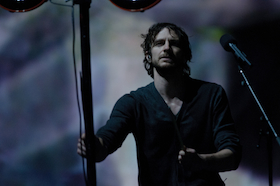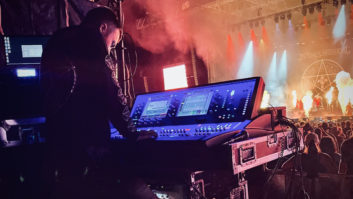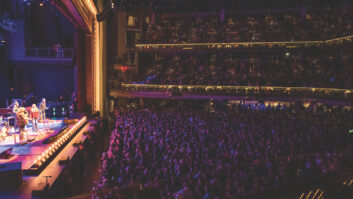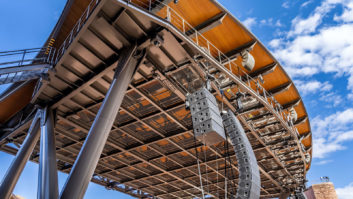
As late as last fall, Gotye was relatively unknown in the U.S. and Europe. Toiling away in his native Australia since 2001, he had some minor success with the song “Heart’s a Mess” locally and in parts of Europe, but nothing would have indicated that Wally de Backer would explode in 2012, riding the song “Somebody That I Used to Know,” which was released in the summer of 2011 on YouTube. As of September 1, the video had been viewed more than 311 million times.
Even that mind-boggling number doesn’t tell the story of how much the song has embedded itself into the world’s musical consciousness. Check out “Somebodies: A YouTube Orchestra,” on Gotye’s YouTube video channel. It’s a video mashup of hundreds of different cover versions of the song, from the well known like Walk Off The Earth’s version around a single guitar (which has generated its own parodies) to other, totally obscure versions.
Riding the wave of the song’s popularity, Gotye embarked on an amphitheater tour of the States in late summer, starting at Red Rocks in Morrison, Colo., after flying in from Japan.
Running sound on the tour is Lachlan Carrick, who started his career as a teenager and has now been mixing for more than 20 years. The summer swing is Carrick’s second tour with Gotye.
“My dad was a musician and I would go to his gigs, and often the only place I could sit was the sound booth, so I got interested in audio that way; I’ve never had a real job,” Carrick laughs. “I also work in other areas—some experimental theater, for example—and I spend a lot of time in the studio. It’s somewhat of a rarity to come out on a long tour like this, but I am really enjoying it.”
Gotye is running a full production rig for the tour. At front of house, Carrick sits at an Avid Venue Profile. “Eighth Day Sound is supplying the gear for this run in the States, so it’s my first night out with it here at Red Rocks,” says Carrick. “The Avid console suits the way I like to work very well. I can make a whole bunch of different sounds with it, then easily automate them, which sounds simple, but the Venue platform takes automation to a whole new level above other digital consoles I’ve used. And obviously, everyone says it, but the TDM plug-ins sound amazing, and are fully integrated. When you’re used to using them in the studio, and the artist is used to using them in the studio, it’s great to be able to apply them in this situation.”
Carrick uses roughly 48 inputs at FOH and employs many different plug-ins out front, preferring them at this point to outboard gear. “The latest thing I’ve been getting into is the Waves Non-Linear Summer, which is a pair of tools that emulate classic console channels and their master buses,” he explains. “They have an SSL, an EMI and a Neve; all these channels are modeled individually from particular consoles. The Drive function is outstanding. I have the NLS channels running on subgroups, and then also the NLS bus over my L/R mix. I mainly use the EMI-style drive on this show, but it just feels like a really nice way to add some extra level and some subtle juice to bring things forward. You can sculpt the way the midrange dynamic works in particular. Great stuff!”

Front-of-house engineer Lachlan Carrick is on his second tour with Gotye.
Gotye likes to use a lot of samples in his songs, triggering them onstage in Ableton Live using three Novation Launchpad 64-button controllers and an Alternate Mode MalletKat Pro MIDI percussion controller. Carrick mixes in stereo with a general stage representation, but the soundstage gets more detailed attention because of all the samples.
“Keeping up with Wally is the most challenging part of the gig, for sure,” Carrick says. “He’s extremely detailed in what he does in the studio, and he applies that to his live shows. He’ll often come out front and have a look at mixes during soundcheck. I use a lot of snapshots tune by tune, and they are all tempo-mapped. The delays I use [Waves H-Delay] are set to follow the tempo, so I then work with them as measure rather than milliseconds. I really like the way you can do tempo-guided release time with the H-Compressor. So with kicks and stuff, you might have an eighth-note release time on the compressor, which is quite a musical sound. So then I don’t have to fine-tune the release times like I would in the studio.
“I use a heap of Waves stuff, actually, like the SSL Master Bus Compressor, the C6 multiband and the L3 Limiter, but I don’t slam the mix very hard, and I don’t mix super-loud, either. I try to mix with a lot of dynamics, so there can be loud parts of the show, and when they kick in it’s quite dramatic—hopefully. Wally’s vocals can be extremely quiet, right through to very loud belting; he’s sort of a chameleon of a vocalist, so working the dynamic of the show around that is paramount.”
Eighth Day also provided the P.A. system, a d&b audiotechnik J Series, and Eighth Day’s Dave Ely was out on the road to help Carrick with system tuning.
“We are using 10 of the J8s, which is the nine-degree box, and then four of the J12, the 20-degree box, on the bottom, to fill in,” Ely explains. “The subs are the d&b B2, a nice punchy box. We have what we call a Q box, a smaller version of the J, and we use the Q for side hangs. We don’t have them up here [at Red Rocks], but I have three of them stacked on top of the subs. We use those for in-fill. The nice thing about d&b is all their boxes work well with each other. It’s not like you have a really good box and then the other doesn’t fit with it. We use the D12 amps, and then we have a Lake Controller just for EQ, basically. Either myself or Lachlan will do the system tuning. There’s quite a lot you can do with the d&b software. It lets you monitor the amps, but you can really fine tune things with it. We can do the timing with either the Lake or the d&b.”
Gotye sings into a Sennheiser 935 head on the latest Sennheiser transmitter. The other microphones were mainly a combination of Earthworks, Sennheiser and AKGs, with a sprinkling of Radial DIs for the computers and the keyboards and a Radial JDX box on the bass amp. The guitar amps are miked with Sennheiser e609s.

Monitor engineer Ben Shapiro.
“I do like to use a dynamic on the vocal; it seems to keep it sounding tighter, especially at high gain,” says Carrick. “The backing vocals are wired versions of the same. For drums and percussion, we have a bunch of Earthworks High Definition Microphones, which I love. We use the SR40s on main kit for kick drum, hi-hats and overheads. Then for Wally’s standup kit, we use DP30Cs on snare and toms. We also use the P30C periscopes. They hover around all sorts of different percussion he plays; they come on and off and get pointed at different things tune by tune. Other than that, there are some AKG 414s doing cymbals and hats on Wally’s kit. Because there are two kits in the show, Wally’s kit and the main kit, I try to keep the microphone selection different to help me make each kit sound more distinctive. The main kit, for example, has Sennheiser e904s on the toms, whereas Wally has the Earthworks condensers, so right away there’s a different tone.”
Handling monitors on the tour is Ben Shapiro, with the assistance of monitor rigger Matt Delia. Shapiro has also been doing sound for more than 20 years, and had previously been at Red Rocks with the John Butler Trio. Shapiro has also worked with a variety of Australian bands, including Crowded House and Midnight Oil, but this is his first tour with Gotye.

The entire band works on in-ear monitors, using a standard Sennheiser ew 300 IEM G3 wireless in-ear system. Like Carrick, Shapiro is mixing on an Avid Venue Profile and using a lot of Waves plug-ins.”I use the Classic Console package, the C6 multiband compressor, Maxx Bass, and then the L3 on the master output along with the NLS bus,” he explains. “Then I use a bunch of H-EQs dedicated for automation. We also run some Buzz Audio hardware channel strips on the front end of Wally’s vocal. They sound great, and they’re extremely flexible.
“The mixes change dramatically from song to song,” Shapiro continues. “Everyone in the band is a multi-instrumentalist, and they all change around quite a lot. Wally has up to three or four changes per song, because he likes different vocal tones and levels as the song progresses. He also plays all sorts of samples and percussion, literally running around the stage and bashing various things. For the band members, I take a more standard approach. Obviously whatever they’re playing is on top, and the bass player and guitar player basically have a more organic drum and bass mix with the computers and tracks and things quite low. Wally is the complete opposite. He has the samples and things he can pitch and lock in—from quiet to quite loud.”







